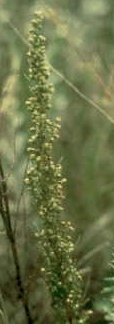 Tarragon
has an Anise-like flavor
that is suited to vinegars and fish, but it also has many other uses in
the kitchen. It has limited medicinal uses, but does have the peculiar property
of causing slight numbness of the mouth when the leaves are chewed.
It is an aromatic
perennial
that is native to Siberia and the Caspian sea area. It enhances the
flavors of many foods, but can become overpowering if excessively used.
It enhances fish, pork, beef, poultry, game, potatoes, tomatoes, carrots,
and most mainstream vegetables. It also goes well with lemons and
oranges. It can be used in cream sauces, herbed butters and vinegars,
soups, sour creams, and yogurt.
Tarragon
has an Anise-like flavor
that is suited to vinegars and fish, but it also has many other uses in
the kitchen. It has limited medicinal uses, but does have the peculiar property
of causing slight numbness of the mouth when the leaves are chewed.
It is an aromatic
perennial
that is native to Siberia and the Caspian sea area. It enhances the
flavors of many foods, but can become overpowering if excessively used.
It enhances fish, pork, beef, poultry, game, potatoes, tomatoes, carrots,
and most mainstream vegetables. It also goes well with lemons and
oranges. It can be used in cream sauces, herbed butters and vinegars,
soups, sour creams, and yogurt.
Tarragon is not a beautiful plant specimen, but it is still a viable herb
to grow in the home garden. It has a rampant root system, and should
be divided every 2-3 years to keep it flavorful and vigorous. It should
be started as seedlings, cuttings, or divisions. The French Tarragon
is much more flavorful for kitchen use than the Russian Tarragon, so be
careful when buying seed. Sprigs can be used anytime, but the main
cuttings should be at 6-8 weeks after setting out and before a killing frost.
Tarragon should be mulched for the winter in the colder climates.
It prefers sandy, well-drained loamy soil and will do well in full sun or
partial shade. It can be divided and potted for the winter, but may
resist transplanting. Be aware also that if you do get over this obstacle,
as an indoor plant it does require a good bit of light.
Tarragon makes a good companion plant
for other herbs and vegetables. Please see
Companion Planting
for more information.
 Tarragon
has an
Tarragon
has an